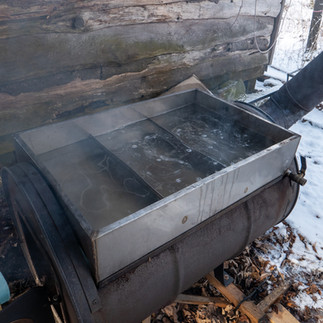Tapping into Sustainability: How Camp DREAM Celebrates Earth Day with Maple Sugaring
- Margaret Bigelow
- 12 minutes ago
- 2 min read
Though Vermont has had a tradition of maple sugaring for centuries, Camp DREAM in Fletcher, VT, just took up the practice three years ago. With its composting toilets and solar-powered lodge, Camp DREAM has focused on environmental sustainability, allowing its campers to connect with nature in ways they may not be able to otherwise. Maple tapping seemed like a natural next step.
How Maple Syrup is Made
The maple sugaring process is relatively simple but time-consuming and requires specific conditions. Maple trees can only be tapped when it is freezing at night but above freezing during the day, limiting the maple season to early spring.

To start, a hole is drilled into the maple tree. A spile is placed inside the hole and then attached to a hose leading into a large bucket. The early spring conditions allow the sap to flow from the tree through the spile and hose into the bucket. From there the sap is filtered two times before being placed into an evaporator. Inside the evaporator are 40 parts water, and 1 part sap. Sap is added to the evaporator until it boils down completely. This process can take four to six hours. Once the sap has boiled down it’s transferred to a smaller pot to be finished off.
Since the timing is quite complicated, campers aren’t always able to be a part of the maple tapping process itself. However, when they are, they learn a variety of valuable skills. Not just how to make maple syrup from scratch, but how to build a fire for the evaporator and the value of making food rather than buying it from the store.
How to Enjoy Maple Syrup
So far this year, Camp DREAM has produced a gallon of maple syrup from 12-14 tapped maple trees. By the end of the season, they are hoping to have another. This will be plenty to get them through a bustling summer camp season.
It’s not just pancakes that Camp uses its syrup for. They also use it in a variety of baked goods and as a sweetener, incorporating it into the meals that the campers help make. According to Camp Director, Elise Oshlag, the highlight of making maple syrup at camp is getting to reveal to their campers that the syrup they’re eating is homemade. It’s quite rare to have syrup that is so fresh, and it is such a joy to bring that to the campers at Camp DREAM.
Treating Every Day Like Earth Day

At Camp DREAM, campers are encouraged to prioritize environmental sustainability every day, not just on Earth Day. As part of their daily activities, campers tend to and harvest from Camp DREAM’s garden. The fruits and vegetables that the campers harvest are then incorporated into their meals each day. Working in the garden along with the camp’s freshly made maple syrup and honey bee hives teaches campers the value of farm-to-table meals.
Read more about DREAM’s environmental efforts by checking out the Camp DREAM web page and reading about our Great Tulip Plant.







Comments